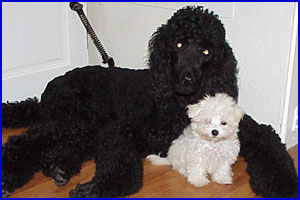
A question asked by many dog owners is how to best introduce a new pup to the already established canine-member of the family. The following applies to the introduction of puppies and older dogs who are ‘new’ to your home and your established dog.
First, jealousy is a human trait, not a canine trait. What dogs experience, when a new family member is introduced, is confusion or insecurity as to their place in the family. A dog who has been the center of attention may become confused and frustrated when that attention is abruptly divided, or even totally redirected, in favor of the newcomer. The dog may then “act out”, attempting to regain the attention that he has lost as a result of the newcomer. If he is improperly corrected, he may act out in a manner that is not compatible with the newcomer. Often the misunderstood dog is then religated to the back yard or a back room, which tells the confused dog that it is no longer in good standing with the family, or worse, to the shelter or streets, which tells him that he has no place in the family at all! It is important to make clear to your pup, from the start, that he is a member of a cooperative group, a family, with you as Parent and him as Child. This has nothing to do with “Dominance” and you being “Alpha”. That concept was disproven more than 30 years ago and was re-visited with the introduction of several TV personalities who still believe the discredited Dominance Theory.
Introducing a new pup to the older dog should be done gradually. The first meeting is best accomplished in a neutral place, like a park, or a neighbor’s yard. They should then be brought home together, where they are allowed to play briefly, outside the house. The pup should then be toileted, (remember that pups usually need to toilet after playing), and then gently and happily placed in a kennel. The kennel should be a good quality wire kennel. It should be large enough for the pup to stand up, turn around and lie down comfortably. It should have a soft cushion, some toys, and a biscuit. It should always be a fun place for the pup to go, never a punishment.
The pup should rest in the kennel for from 15 to 20 minutes after which time the pup is taken outside to toilet. (This will facilitate toilet training as well as introduction to the older dog.) Remember, pups also need to eliminate after a nap.
The pup is then re-introduced to the older dog with a very “up”, happy tone of voice. It is important to be neither forceful nor overly cautious about the introduction. A very positive and matter of fact attitude is best.
The play times should last a few minutes at a time, always supervised. The pup should not be permitted to annoy the older dog. Gently correct the pup and teach it to be careful, using the cue “careful”, not to injure the older dog with its sharp teeth. The established dog must be included in the play time and actually receive MORE attention than the puppy.
Be sensitive to the older dog remembering to give him as much or more attention and personal time as you always have and at least as much time as you give the new pup. Run through his training cues once or twice a day. This assures the dog that he has not lost his place in the family.
The older dog should not be permitted to “mark”, (urinate on structures around), the house, yard or neighborhood. This “territorializing” is the method dogs use to establish ‘ownership’ of the area. Have the older dog neutered, if you have not already done so. This is a good idea even if you are not introducing a new dog to the family. Neutering of both males and females lessens the incidence of mammary and prostate cancer, eliminate the possibility of uterine, ovarian or testicular cancer and makes them calmer and more loyal pets.
Always have your dog under control when introducing him/her to a new pup/dog, remembering that dogs are never totally predictable.
Finally, it is VERY important that you do NOT punish your older dog if s/he growls at the puppy when the pup bites the older dog. To do so will disrupt the natural behavior of an adult dog to correct and teach the puppy how to get on with other dogs. It will also cause your dog to associate the newcomer with punishment and so to resent it. If you console the pup and punish the adult dog, the adult will wait for the opportunity, when you are not available to punish, and may attack the pup in order to remind the pup that he considers the puppy an intruder. The results may be more aggressive than the original warning growl.

